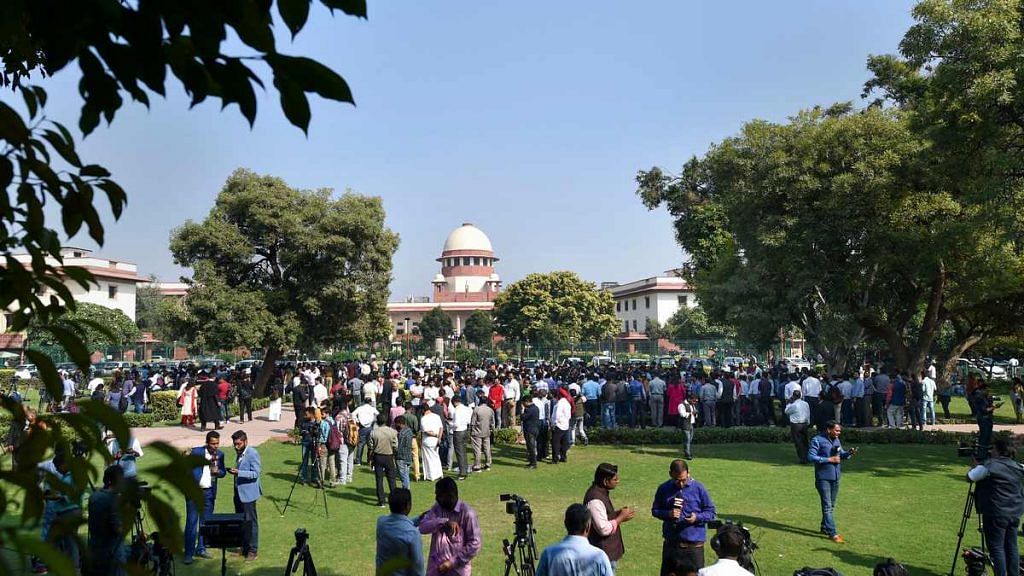To analyse, much less critique, a 1,045 page, 805 paragraph and 3.03 lakh word Supreme Court (SC) judgment before the ink on it is dry is neither possible, nor apposite. While a comprehensive critique must await fuller study, a few legal, political and general points are nevertheless in order.
First, we tend to ignore the remarkable achievement of a unanimous Constitution Bench judgment on a highly fractious and divisive issue, riven by law, factual controversy, emotions, archaeological evidence and historical treatises. Far lesser cases have led to 4-1 or 3-2 verdicts. The court must be publicly applauded for this unanimous approach which sends out its own clear and significant message to all segments of Indian society. It also immeasurably enhances the strength and weight of the judgment.
Second, the only correct, efficacious and lasting solution to this highly divisive issue is a binding judgment of the apex court. Neither the best intentioned mediation, nor any bonafide government or a responsible opposition can achieve the quietus and finality which a reasoned apex court judgment can.
Third, it is neither the job of an apex court nor humanly possible in any system to satisfy every litigant or every stakeholder. To be human is to be fallible. More than anyone else, the SC has said so in innumerable judgments. The SC is right because it is final, and not final because it is right. And that can and should never be a ground for uninformed criticism.
Fourth, while the judgment has opened the doors for the swift construction of a grand temple (and a much larger space elsewhere in the same city for a grand mosque), it has also rightly closed the doors to constant politicisation of this issue, its exploitation for cheap sensationalism or petty political gains, or for flogging a festering sore to extract unnecessary mileage for ulterior motives. Thus, the very desirable opening of some doors has led to the equally commendable closing of other doors.
Fifth, a bare look at the text of this long judgment shows that the court has laboured long and hard, and most of its findings are unexceptionable. It has held the Akhara’s suit barred by limitation, as the dates clearly show. It holds proceedings by others (including the Sunni board) to be within limitation. It has rightly held that while the deity has an independent right to sue, a mere Poojari cannot be equated with a Shebait, because the latter is supposed to be an agent of the idol and entrusted with the idol’s property to manage it, which has not been established by any evidence. Equally, it has rightly held the later suits maintainable, noting that the earlier 1885 suit was for distinct prayers relating merely to the Ram Chabutara and filed by different parties (pr. 446). Similarly, it held the Sunni suit to be maintainable (pr 627).
Sixth, in important findings from paras 795 to 801, the court has, after analysing a humongous amount of evidence, held that the Hindus have continuously used the outer courtyard from inception; that the Hindus have even used the inner courtyard from well before 1857; that though the Muslims also intermittently offered prayers in the inner courtyard area from 1600 to 1949, they were unable to establish their exclusive possession of the inner courtyard; that, however, their longstanding practice of Namaz in the inner courtyard was unlawfully stopped in 1949 and consequently, while they had failed to prove exclusive possessory rights, their longstanding (although irregular) practice of Namaz and their unlawful ouster in 1949 justified the invocation of special apex court powers under article 142 of the Constitution to award restitution and direct the availability of a five-acre alternative site in Ayodhya for the construction of a new mosque.
Seventh, from paras 508 to 512, the court has analysed in great detail and endorsed the Archaeological Survey of India (ASI) report which gave clear factual findings on the pre-existence of a big structure beneath the demolished mosque structure; the fact that the earlier structure was non-Islamic; and that it had several motifs and features which related to Hindu culture and religion. The Supreme Court thus upheld the conclusion of Justice Sudhir Agarwal of the High Court that the ASI’s omission to give one crucial finding (namely whether the earlier structure was a temple or not) would not change anything.
Several other paras discuss the question of faith and belief which undeniably establishes the fact that the Hindus consider this spot as the birthplace of Lord Ram ( paras 556-558). The relief granted is, however, clearly not founded upon mere faith and belief.
None of the above reasoning or findings can be said to be perverse, unknown to law, or dehors established legal principles of judicial adjudication. It is entirely possible for legal practitioners, politicians and citizens alike to quibble about legal niceties and political rhetoric (indeed, democracy would be in danger if this cacophony was absent). But it would be unwise, hasty, knee-jerk and irresponsible to launch broadsides of uninformed criticism against this comprehensive judgment.
Abhishek Singhvi is a member of Parliament, the national spokesperson of the Congress, former chairman, Parliamentary Committee on Law & Justice, and former additional solicitor general of India
By special arrangement with
Also read: Ram mandir’s done, now Modi can’t ride more Hindu nationalism as economy is stalling
